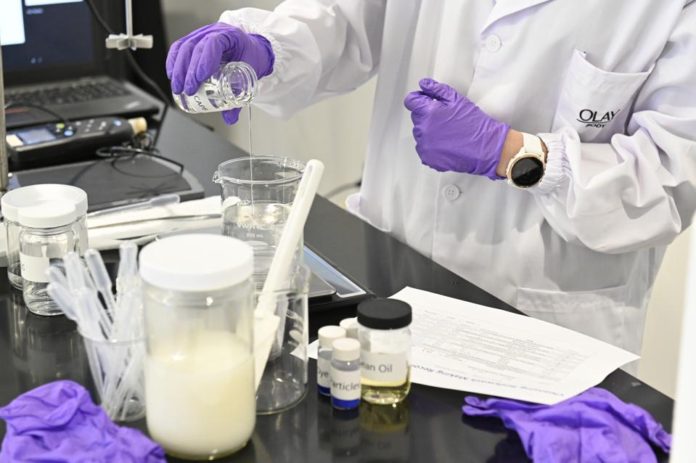
MASON, OHIO – P&G Mason Business Center on February 21, 2020 in Mason, Ohio. Photo by Duane … [+]
A study that suggests straight men outnumber gay men might be easily dismissed as “no duh.” But it turns out, there’s more to this research than the obvious. It pulls back the curtain on yet another gap in how colleges and universities educate — and corporations employ — people in four specific disciplines: science, technology, engineering and mathematics, or STEM.

NEW YORK, NY: Marchers and spectators high-fiving each other during the Gay Pride March on June 30, … [+]
First, there’s a misconception among most American adults about just how many LGBTQ people there are in the U.S. A 2019 Gallup poll showed that most American adults believe that almost one in four of us is either gay or lesbian. But according to researchers, our LGBTQ population is actually far smaller.
A study published by Statista in 2017 determined that about only one in 100 American women, and two in 100 American men, identify as gay: Put another way, that’s 1% of the U.S. is lesbian, 2.2% of all American men are gay. Statista says another 4% of all Americans identify as bisexual; Transgender Americans account for only 0.6% of the U.S. population, the Williams Institute at UCLA concluded in 2016.
Given that LGBTQ Americans amount to a smaller population than heterosexuals, it’s been presumed but not proven they also are outnumbered in fields like science, technology, engineering and mathematics.
MORE FOR YOU
Until now, researchers have focused largely on the gender gap in STEM, where the U.S. Department of Commerce reports women are still drastically under-represented in higher education and hold fewer than 25% of STEM jobs, even though women fill close to half of all jobs in the U.S. economy. This has been the case since at least 2010, despite college-educated women increasing their presence in the overall U.S. workforce.
For the first time, researchers have confirmed another gap exists, this one impacting gay, lesbian and bisexual people studying and working in STEM.
Ten days ago, Vanderbilt University announced two economists had concluded that gay men in same-sex couples are 12% less likely to have a STEM-related bachelor’s degree than straight and bisexual men whose partners were women. According to Vanderbilt’s news release, their research suggests that discrimination and workplace harassment may bar or force qualified scientists out of the jobs for which they were educated and trained.
The economists found that the sexual orientation gap between straight and gay men is greater than the STEM racial divide, a 4-point disparity between Black men and white men.
However, the racial gap and sexual orientation gap remain far smaller than the aforementioned female to male gender gap: Vanderbilt described it in its news release as “the 21-point chasm between women and men in STEM.” Efforts to close the gender gap will likely impact this newly-confirmed sexual orientation gap, the researchers concluded.
When there are more women in STEM occupations, they found, there are also more gay men in those same occupations. This, they say, suggests that closing the STEM gender gap may also help reduce the sexual orientation gap in STEM.
The economists did make an important finding regarding lesbian women: “There is essentially no gap among bachelor’s degree holders in STEM degrees between women in same-sex couples and women in different-sex couples,” the researchers wrote, referring to couples consisting of one man and one woman. But that’s not all they found:
“We observe that a larger share of women in same-sex couples are in STEM occupations than women in different-sex couples.”

Prof. Dario Sansone, Ph.D., left, and Prof. Christopher Carpenter, Ph.D. are the authors of Turing’s … [+]
Economics Prof. Christopher S. Carpenter, Ph.D., whose nickname is Kitt, collaborated on this research with Prof. Dario Sansone, Ph.D. of the University of Exeter in the U.K.
Dr. Carpenter is the E. Bronson Ingram Chair and Professor of Economics and Director of Vanderbilt’s LGBT Policy Lab. Dr. Sansone is a former Vanderbilt postdoctoral scholar and current economics lecturer at Exeter. They published their paper, Turing’s children: Representation of sexual minorities in STEM, in the journal PLOS One on Nov. 18.
For their paper, Carpenter and Sansone studied 142,641 men and women in same-sex couples and 10.8 million couples consisting of a man and a woman. Their data was provided by the U.S. Census American Community Surveys from 2009–2018, and the Centers for Disease Control’s National Health Interview Surveys, conducted between 2013 and 2018.
Among those same-sex couples, 1,213 self-identified as lesbian or gay women, 1,524 self-identified as gay men, 1,113 women and 426 men self-identified as bisexual. In addition, 279 women and 208 men responded that they identified as “something else.”
Carpenter told me via email they did not find bisexual men “were differentially likely to have STEM occupations than similarly situated heterosexual men.” When asked about the total absence of data regarding transgender people — given that someone who is trans also can be gay, lesbian, bisexual, asexual, poly, pan or any sexual orientation, Carpenter had this to say:
“We are absolutely aware that trans folx can be of any sexual orientation. To be clear: we do not observe gender identity/transgender status of anyone in any of the data we use. It is a data limitation that we try to be clear about in the paper.”
Carpenter and Sansone noted in their paper that although they could not directly comment on STEM representation differences associated with gender identity due to those data limitations, their work is yet another reminder that nationally representative research is desperately needed into both sexual and gender minorities in STEM.
Doing so would go a long way toward better understanding LGBTQ representation in education and in the private sector, as well as the barriers and challenges faced by the community, they wrote.
Something else Sansone and Carpenter found “particularly interesting:” men in same-sex couples with bachelor’s degrees achieved a degree in STEM at a far lower rate than men in heterosexual relationships.
Men in in same-sex couples with bachelor’s degrees are 34.5% less likely to have completed that bachelor’s degree in a STEM field than men in different-sex couples who earned a bachelor’s degree. That’s despite being 43.6% more likely to have a bachelor’s degree at all than men in different-sex couples.
Sansone wrote in their paper that this finding suggests that the factors that perpetuate the very large gender gap in STEM fields — “heteropatriarchy, implicit and explicit bias, sexual harassment, unequal access to funding, and fewer speaking invitations” — are related to this newly identified gap in STEM fields between gay men and heterosexual men. He also concluded that misperceptions of all gay men as feminine and all lesbians as masculine contribute to the sexual orientation gap:
“Addressing these gaps could increase efficiency by improving group decision — making, company performance and the quality of scientific work. In addition, increasing the number of LGBQ people in STEM could help to alleviate the chronic shortage of workers in these fields.”
Their bottom line: with no national scientific body currently collecting data on LGBTQ people in STEM, the sexual orientation and gender gaps can only be closed with more research, and fewer obstacles to those already studying and working in those fields.
“A lack of data, coupled with well-documented discriminatory practices against LGBQ scientists across STEM fields, has left the research community and policymakers with no clear sense of the scope of improvements that need to be made,” added Carpenter. “As with all systems, diversity is a strength. We intend for our findings to contribute to the body of research that will shape data-informed policy that protects and encourages diverse participation in STEM.”
Read the full paper by Dr. Carpenter and Dr. Sansone by clicking here.







